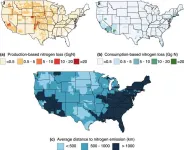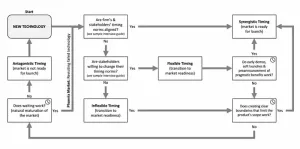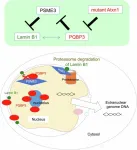(Press-News.org) After four years, a guidebook for the future of autonomous trucking has driven across the finish line.
In 2020, the Virginia Tech Transportation Institute (VTTI) and 17 partners were awarded a $7.5 million grant from the U.S. Department of Transportation to develop a concept of operations. The final report, published in July, includes best practices for the implementation of automated driving systems (ADS) in large trucks and policy issues for fleets to consider across eight topic areas.
“We’re excited that the Federal Motor Carrier Safety Administration's grant to the Virginia Tech Transportation Institute for the Fleet Concept of Operations exceeded the grant requirements for both activities and matching contributions,” said Tom Kelly, the Federal Motor Carrier Safety Administration's technical point of contact for the grant. “They accomplished their goal to demonstrate several different concepts of potential ADS truck applications and research key operational issues such as insurance, roadway readiness, and fleet safety management practices. All of this culminated in a ‘playbook’ for trucking fleets considering ADS operations in the future. In addition to the research findings, the grant created a publicly available data set containing thousands of miles of ADS operations data.”
The guidelines focus on eight topic areas:
Fleet specifications
System installation and maintenance guide
ADS inspection procedures
Drive state monitoring
Motor carrier guide to insuring automated driving system-equipped trucks
Identification of automated driving system-equipped truck safety metrics and variables
Road readiness assessment system
Data transfer and cybersecurity best practices
The guidelines were just one outcome of the work, known as the Fleet of Concept Operations project (CONOPS), which also included four other goals:
Observe and report on practices related to safely integrating automated driving system-equipped trucks into the U.S. on-road transportation system.
Collect datat to support the modernization of regulations by the U.S. Department of Transportation.
Demonstrate the integration of automated driving system-equipped trucks in a productive, cooperative way into existing road freight ecosystems.
Collaborate with government entities, university and research institutes, trucking associations, and private partners.
“The goal of the CONOPS project was to provide the trucking industry with guidelines on how to safely implement, integrate, and benefit from automated driving system-equipped trucks," said Rich Hanowski, director of the Division of Freight, Transit, and Heavy Vehicle Safety at VTTI. “The research conducted, including the on-road demonstrations, provides new insights and examples of successful deployments that fleets interested in integrating ADS can emulate."
To accomplish these four goals and develop the eight guidelines, the research team conducted in-the-field operational use cases, organized a variety of demonstrations and public outreach activities, and developed a Dataverse.
Operational use cases
The primary source of data collection was three operational use cases in which an automated driving system-equipped truck would be beneficial:
A five-day deployment at the Port of Oakland in California
A team completing five cross-country road trips with an automated driving system-equipped truck, totaling more than 15,000 miles
An evaluation of drivers’ actions when a vehicle is operating in an autonomous function in Whitter, Alaska, and an analysis of other ways autonomous functions could improve the supply chain
Demonstrations and public outreach
Throughout the data collection and use cases, VTTI also hosted a series of public outreach events. This included events in Charlotte, Orlando, and Dallas, during which patrons saw automated driving system demonstrations, viewed a live streamed of the cross-country data collection, and even had the opportunity to ride in an automated truck.
These events were aided by VTTI’s multiple project partners, including the San Francisco-based autonomous trucking company Pronto.ai.
“We showcased different aspects of Level 4 truck automation [high automation that still allows for human override] operations and what those might be able to look like in the future,” said Ognen Stojanovski, co-founder of Pronto.ai. “This was a demonstration of being able to integrate and deploy these kinds of technologies into the existing transportation ecosystem.”
During the event in Dallas, Kodiak Robotics provided a demonstration of an enhanced commercial motor vehicle inspection on a truck equipped with an automated driving system.
“As a leader in the autonomous technology industry, we are incredibly excited about the opportunity to enhance the safety of American highways that use the enhanced inspection program,” said Daniel Goff, Kodiak’s head of policy. “This enhanced inspection ensures that all trucks are inspected to an incredibly high standard so that law enforcement has confidence in the quality of the inspection and the roadworthiness of the trucks.”
Data usage
To support the collected data, the CONOPS Dataverse was developed to house data from the events and deployments. Hosted by VTTI, the Dataverse includes four separate collections consisting of 94 data sets each, including the following:
Data generated from the operation of the advanced driver assistance systems and automated driving system-equipped trucks, including video, kinematic, radar, GPS, and other sensors
Driver monitoring datasets from the automated driving system-equipped vehicles during the three use cases
Survey responses obtained from the public during the outreach events. The data is publicly available for use by researchers, policymakers, and others seeking insights into the future of automation in trucking.
The road ahead
While further research and development is needed for total fleet adoption, researchers said the Fleet of Concept Operations project guidelines provide the essential starting point for any fleet as well as a baseline understanding of where the industry stands with the implementation of automated driving systems in the field and what next steps are required for successful adoption.
“Automation should be developed in partnership with the humans operating around or responsible for the system,” said Andrew Krum, the project’s principal investigator and senior research associate at VTTI. “While many factors still need to be addressed, specifically fleet by fleet, this concept of operations is the first of its kind and can help to guide the future of automation in trucking fleets."
The report is available on the project website.
END
Guidelines to steer the future of autonomous trucking
2024-09-03
ELSE PRESS RELEASES FROM THIS DATE:
From cavities to sleep apnea: dentists can assume new role in saving lives
2024-09-03
A patient dozes off in a dental chair despite the anxiety of an impending procedure. A seemingly unremarkable act but — for dentists versed in the latest sleep research — this red flag hints at a life-threatening condition.
In a research review published in the Journal of the American Dental Association, Rutgers Health researchers identified dentists as an unexpected player in the battle against life-threatening sleep disorders.
The review suggests dental professionals have unique opportunities to screen for conditions such as obstructive sleep apnea, a disorder that affects millions of Americans and is linked to serious health risks, including cardiovascular ...
Department of Energy awards $125 Million for research to enable next-generation batteries and energy storage
2024-09-03
WASHINGTON, D.C. - Today, the U.S. Department of Energy (DOE) announced $125 million in funding for two Energy Innovation Hub teams to provide the scientific foundation needed to seed and accelerate next generation technologies beyond today’s generation of lithium (Li)-ion batteries. These multi-institution research teams, led by Argonne National Laboratory and Stanford University, will develop scientific concepts and understanding to impact decarbonization of transportation and incorporation of clean energy into the electricity grid.
Rechargeable batteries, such as Li-ion and lead-acid batteries, have had a ...
New provincial funding to help drive connected and autonomous vehicle research at uOttawa
2024-09-03
The University of Ottawa has been awarded a $1 million grant from the Ontario Research Fund – Research Excellence (ORF-RE) to support the “Secure, Intelligent and Trustworthy Ecosystems for Connected and Autonomous Vehicles” (SITE-CAV) project.
Led by Burak Kantarci,Full Professor, School of Electrical Engineering and Computer Science, uOttawa’s Faculty of Engineering, the project aims to accelerate the development and integration of connected and autonomous vehicles (CAVs – or vehicles equipped with sensors and decision-making software that drives and controls it without direct ...
Department of Energy selects Argonne to lead national energy storage hub
2024-09-03
Today the U.S. Department of Energy (DOE) announced the creation of two new Energy Innovation Hubs. One of the national hubs, the Energy Storage Research Alliance (ESRA), is led by DOE’s Argonne National Laboratory and co-led by DOE’s Lawrence Berkeley National Laboratory (Berkeley Lab) and Pacific Northwest National Laboratory (PNNL).
ESRA (pronounced ez-ruh) brings together nearly 50 world-class researchers from three national laboratories and 12 universities to provide the scientific ...
People eating beef are less likely to live near the industry’s pollution, Pitt researchers found
2024-09-03
Anyone who’s researched ways to lower their environmental impact has likely heard they should eat less meat, particularly beef. Even at scale, cows are an inefficient way to feed people — it takes nearly four tons of water to recoup one ton of beef, and many farming practices emit greenhouse gasses and pollutants.
University of Pittsburgh researchers are the first to trace one of those pollutants, nitrogen, along the U.S. beef supply chain at the county level. They found high spatial disconnect between where ...
Can technology turn exercise pain into pleasure?
2024-09-03
Virtual reality (VR) video games that combine screen time with exercise are a great way to get fit, but game designers face a major challenge – like with regular exercise, adherence to ‘exergames’ is low, with most users dropping out once they start to feel uncomfortable or bored.
Computer scientists at the University of Bath believe they’ve found a solution: create exergames that use sensors to continuously measure a person’s emotional state while they exercise, then tweak the game – for instance, making ...
When is the right time to launch new technologies?
2024-09-03
New research from Bayes Business School (formerly Cass) finds that being on the cutting edge of technology is not enough to ensure success in the market, and managers must strategically time launches to create a source of opportunity and credibility for the firm.
The study, led by Dr Thomas Robinson, Senior Lecturer in Marketing at Bayes, with Dr Ela Veresiu, Associate Professor of Marketing at Schulich School of Business, York University, Toronto, develops a framework for guiding organisations on the best situations for a product launch.
The research identifies four timing situations that can confront marketing managers. Knowing ...
Mayo researchers develop tool that measures health of a person’s gut microbiome
2024-09-03
ROCHESTER, Minn. — A team of Mayo Clinic researchers has developed an innovative computational tool that analyzes the gut microbiome, a complex ecosystem of trillions of bacteria, fungi, viruses and other microorganisms within the digestive system, to provide insights into overall well-being.
In a new study published in Nature Communications, the tool demonstrated at least 80% accuracy in differentiating healthy individuals from those with any disease. The tool was developed by analyzing ...
Unveiling the molecular mechanisms linking aging with neurodegenerative diseases
2024-09-03
Tokyo Medical and Dental University (TMDU) researchers elucidate the role of PQBP3 in stabilizing the nuclear membrane and its relationship to senescence and neurodegeneration
Tokyo, Japan – Aging is the prime cause of neurodegenerative diseases, such as Alzheimer’s disease, Parkinson's disease, and amyotrophic lateral sclerosis. But what exactly increases the prevalence of these brain disorders as one grows older? The molecular forces linking aging, cellular senescence, and the onset of these neurodegenerative conditions ...
Keep devices out of bed for better sleep – Otago study
2024-09-03
Despite what we’ve been led to believe, the timing of evening screen use, rather than the activity itself, negatively impacts youth sleep, a University of Otago study has found.
Current sleep guidelines recommend no screen use in the hour or two before bed. However, the researchers found screen time in the two hours before bed had little impact on youth sleep, it was screen time once in bed that caused problems.
Lead author Dr Bradley Brosnan, of the Edgar Diabetes and Obesity Research Centre, says screen time is a mainstay in adolescents’ bedtime routines, and sleep guidelines need to be revaluated to better reflect modern life.
Published in JAMA Pediatrics, ...




